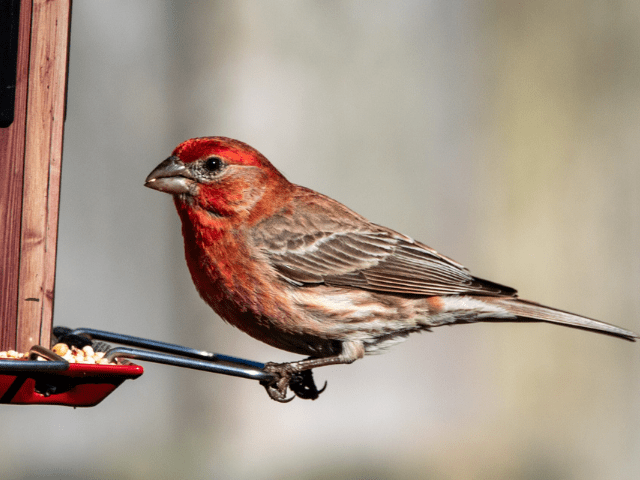Finches are small songbirds that you may find to be ideal pets.
What's more...
These adorable creatures come in various shapes, sizes, and even color patterns.
Although each finch belongs in one category, you will be surprised to discover how unique they are. And this article will guide you in taking a closer look at the finches in Michigan.
An Overview Of Different Michigan Finches
Michigan is home to several species of finches due to its rather convenient geography. However, most of the Michigan finch species are not native to the state, despite what you may initially think.
Many experts say that Michigan finches originate in Canada, and they consider them as “birds of the north.” With Michigan’s diverse selection of finches, the state naturally attracts plenty of bird enthusiasts all year round.
In the next section, you get to discover exciting facts about the eight types of finches in Michigan and their unique characteristics.
1. American Goldfinch
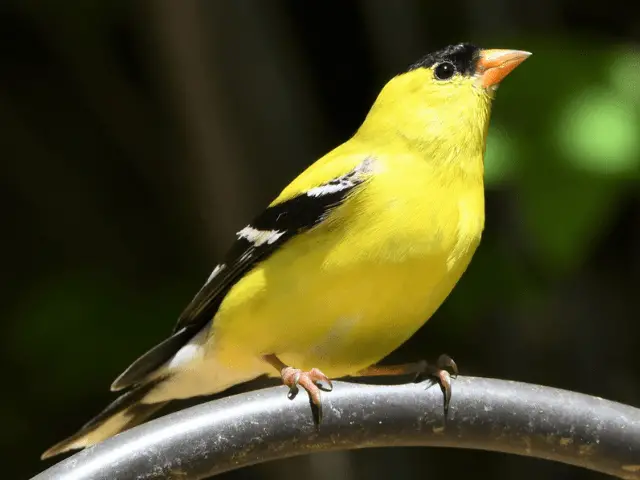
Measurements
- Wingspan: 7 - 9 inches
- Weight: 0.4 - 0.7 ounces
- Length: 4 - 5 inches
Appearance
An interesting thing about the American goldfinch is that their appearance varies depending on their sex.
Adult males in early summer highlight a very vibrant yellow which perfectly compliments their “goldfinch” name.
On the other hand, the female variety of the species displays a duller pattern of yellow, black, and white throughout its body.
These birds also have a distinct black patch on their forehead and jet-black wings, and a few white streaks.
Temperament
Being the small birds that they are, you will regularly see American goldfinches latching onto all sorts of branches and weeds. You could even catch them visiting bird feeders or just pecking at seeds on the ground.
Birders can easily spot the American goldfinch because of their acrobatic flight patterns as well as their attention-grabbing calls.
Habitat
It is not uncommon to find the American goldfinch nesting in floodplains and weedy fields. Goldfinches simply love environments filled with various greenery. However, you can also see these birds frequently roaming around backyards, roadsides, and even orchards.
You can find the American goldfinch in Michigan just about any day of the year, unlike other finch species in the state.
2. Pine Siskin
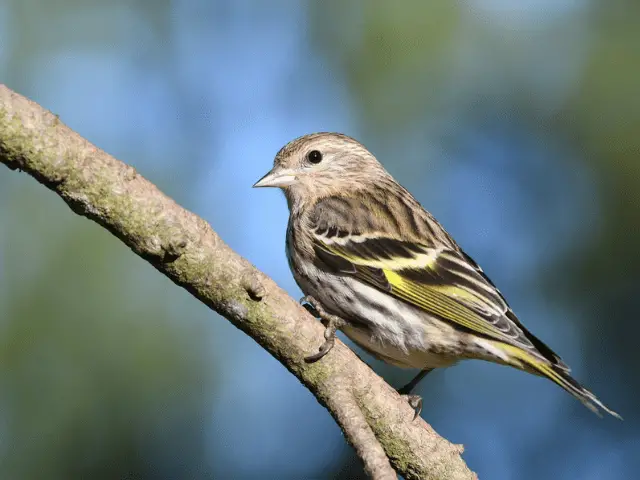
Measurements
- Wingspan: 7 - 9 inches
- Weight: 0.4 - 0.6 ounces
- Length: 4 - 6 inches
Appearance
The pine siskin is comparable to the small and compact build of American goldfinches. Measurements aside, the pine siskin could not be any more different.
These birds have tiny but sharp beaks that match their brown and yellow striped body. You can observe this beautiful and unique color scheme from their heads to their tails.
Temperament
Pine siskins are the kind of gentle birds that frequently visit feeders, especially during the winter seasons. Although they travel to look for food inside bushes and trees, the pine siskin is not a picky eater and snacks on an assortment of seeds.
They occasionally scan the ground looking for seeds as most birds would with their very gentle nature and slight build.
Habitat
While they love the fresh air high up in pine trees, the pine siskin adapts to plenty of different environments. You can find these birds deep into tall forests, but you can also see them staying near open fields and even yards.
3. House Finch
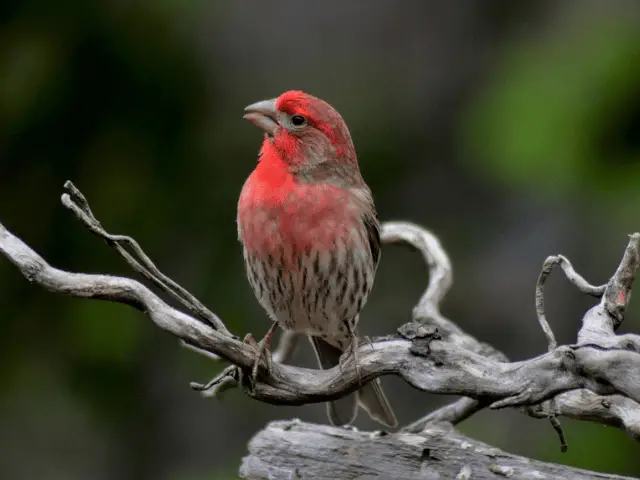
Measurements
- Wingspan: 8 -10 inches
- Weight: 0.6 - 1 ounces
- Length: 5 quickly- 6 inches
Appearance
House finches generally have small bodies, a medium-sized beak, and a relatively long tail.
Adult male house finches have a rich red color that starts from their head and fades into white around the lower half of their underbellies.
However, adult females of the species do not have the vibrant colors of their male counterparts.
Some birders often mistake this bird for a Cassin's finch since they share similar looks, except that the orange-red shade is more dominant among house finches.
Temperament
If you are looking to take pictures of finches in Michigan, then a house finch is probably your best bet. The house finch’s gentle nature enables enthusiasts to take photos without startling them.
You can effortlessly identify these finches by their adorable small hops on the ground and firm posture on trees.
Moreover, they are noticeably lively when in backyards; however, they are birds that also get jumpy way too quickly, so they can get aggressive at times.
You can spot these birds in the air by their signature bouncy flight patterns, but they are reclusive during their breeding season.
Habitat
Luckily enough, you do not have to look very far to find a house finch. As their name may imply, you can see these birds inside the homes of many. House Finches are otherwise known to visit populated areas such as state parks, urban areas, and back yards.
Whether you are looking to take a photo or get a feathery pet, this Michigan finch is a common but beautiful bird. You will most likely encounter these birds in farmlands, cities, spaces where lawns and trees are abundant, and semi-open areas.
4. Common Redpoll
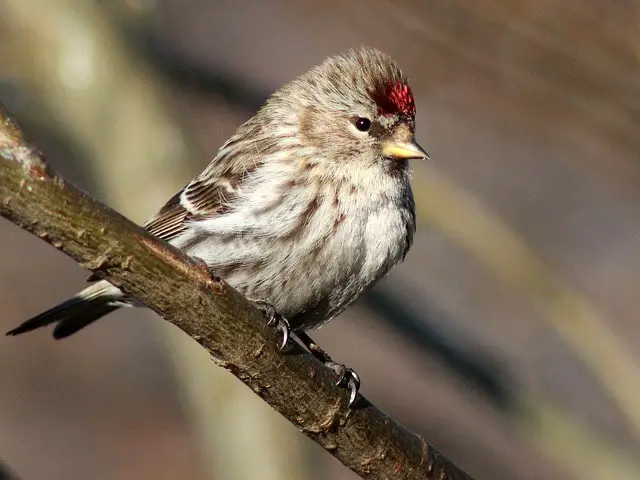
Measurements
- Wingspan: 7 - 9 inches
- Weight: 0.4 - 0.7 ounces
- Length: 4 - 6 inches
Appearance
Despite what their name may lead you to think, the common redpolls are not common in America. It is only during the winter seasons in Michigan that you can spot these birds in the state.
Male common redpolls will have hints of red on their chest and underbellies, but both sexes have patterned streaks of brown and white along their body.
Temperament
Redpolls may be small creatures, but they certainly make up for it with their masses. You will often see the common redpoll flying in flocks of hundreds during winter.
Many experts note the common redpoll by their tendency to travel from one place to another to look for seeds. For this reason, common redpolls are very efficient at search and collecting food.
Habitats
Common redpolls are not regularly found in Michigan and are fond of chilly, northern habitats. You can often spot these birds staying in conifer forests and even wide, open spaces seasonally. If you are lucky enough, you might even catch them visiting a bird feeder.
5. Purple Finch
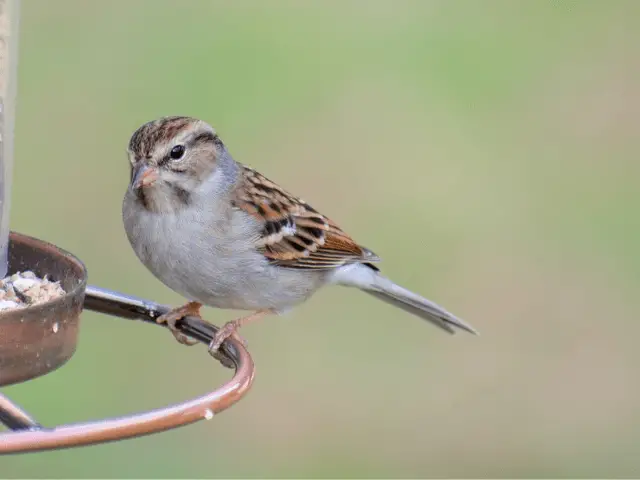
Measurements
- Wingspan: 8 -10 inches
- Weight: 0.5 - 1.1 ounces
- Length: 4 - 6 inches
Appearance
You shouldn’t let the name fool you. Purple finches are red and not purple.
On the other hand, experienced eyes will spot a purple finch by their brown back and pinkish-white underbellies. Purple finches tend to have a more prosperous and an intenser red upper half than a house finch.
Additionally, female purple finches do not have the beautiful red that males do. You can still conveniently identify a female purple finch because of their distinct facial lines and stripes along their necks.
Temperament
Like every other Michigan finch on this list, purple finches frequently visit feeders. In their own time, these beautiful birds search for black oil sunflower seeds because they are foragers.
Enthusiasts can spot these birds perching atop high branches looking to feed on all sorts of seeds. If necessary, they also scour the ground of weedy fields and plants.
Habitat
Purple finches are found in many coniferous forests in Michigan, especially when breeding season comes along. However, this species also adapts to different environments such as yards, shrubs, and even fields.
6. White-Winged Crossbill
Measurements
- Wingspan: 10 - 11 inches
- Weight: 0.8 - 0.9 ounces
- Length: 6 - 7 inches
Appearance
The white-winged crossbill is the kind of finch you can spot from a mile away. You can recognize a winged crossbill by its beautiful rose-pink color that blends with black and white all over its body.
Although young males and females of the species are yellowish, white-wings crossbill has wings that start with specks of red but end with black and white wingtips. Any birder can also find this pattern on their tails.
Temperament
Many bird enthusiasts will discover that white-winged crossbills always travel in flocks regardless of the season. The white-winged crossbill is a forager like most finches and is mostly prying into rigid cones with their sturdy crossed bills.
They are mostly quiet when there's adequate food supply, but if the circumstances are not favorable, you will hear them calling while foraging.
Habitat
Interestingly enough, these birds transfer from place to place depending on the abundance of coniferous cones. Some of their favorite habitats are boreal forests of spruce and tamarack.
When spruce and other cones are scarce, large flocks of white-winged crossbills will wander away from their habitat’s range and search for food elsewhere.
7. Hoary Redpoll
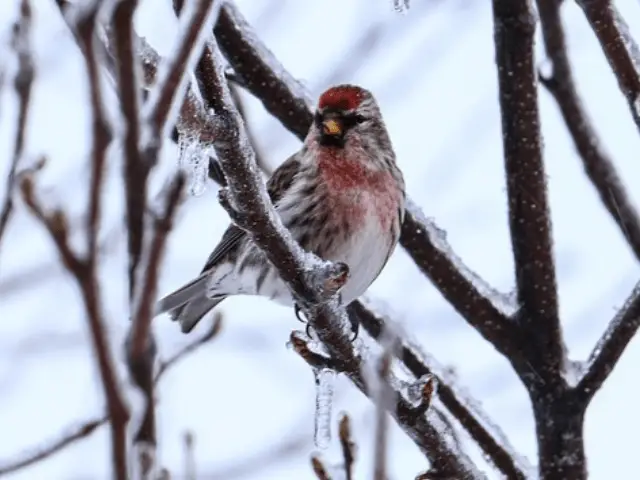
Measurements
- Wingspan: 9 - 10 inches
- Weight: 0.4 - 0.7 ounces
- Length: 4 - 6 inches
Appearance
Hoary redpolls are most noticeable for their tiny faces and beaks. These beautiful songbirds feature gray and brown streaks all over their backs. The hoary redpoll also boasts a beautiful gray tail and matching gray wings that neatly fold when perched.
Adults of the species will have a small bright red patch on their foreheads, making them easy to spot. Although not many, you may be able to see some hoary redpolls displaying a pinkish color on their broad chests.
Temperament
As another finch in Michigan, it is only natural that the hoary redpoll is a forager. Regularly flying in flocks, these gentle birds feed on seeds off the ground and even directly from plants.
Friendly as they are, these birds will sometimes flock with common redpolls after breeding season.
Habitats
If you encounter a Tundra in Michigan, you might be able to spot a hoary redpoll perching on a slanted tree branch. Being birds of the north, hoary redpolls love perching high-up trees and occasionally visit bird feeders and fields.
8. Red Crossbill
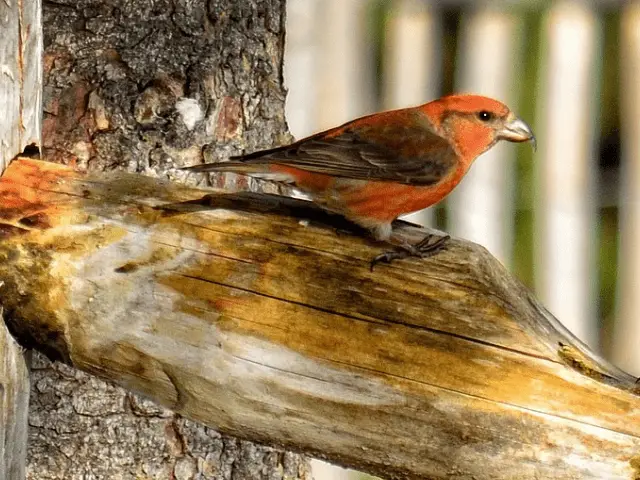
Measurements
- Wingspan: 10 - 11 inches
- Weight: 1 - 2 ounces
- Length: 7 - 8 inches
Appearance
The red crossbill lives up to its name with the presence of orange-red color all over its body. While females can have a combination of yellow and brown, both male and female varieties of the species are overall red with hints of brown.
A French naturalist named Comte de Buffon sees their beak's structure as nature's defect with no significance at all. Their wings are also brownish and lacking wing bars.
Temperament
Red Crossbills are often seen foraging and eating conifer seeds in flocks and flying from tree to tree. You can often observe this species gathering grit on the ground when they are not in flight; they typically don't migrate except when conifer seeds are scarce.
Adult red crossbills are also wary and settle on top of conifers to look out for potential predators. While these birds mostly eat seeds, they also prefer to feed on berries and tree buds. Their acrobatic skills are exceptional, displaying impressive agility when climbing pine cones.
Habitat
Because they mainly feed on conifer seeds, red crossbills live in old coniferous forests for convenience, but they also prefer to dwell in places where spruces and pines are abundant.
The only time they leave their habitats is when they need more food. During these times, you can see Red Crossbills travel in flocks across towns and forests.
Fun Fact: Have more fun with woodpeckers in Pennsylvania and discover how much they are similar to the finches!
Frequently Asked Questions
Are there finches in Michigan?
Yes, there are. Michigan offers a total of eight different species of finches. Although this number jumps to ten seasonally, you can find these species of finches all over the state.
Are there blue finches in Michigan?
No, there are none! Michigan finches all share the color red on their bodies.
Do finches stay in Michigan for the winter?
Yes, they do. Michigan finches are birds of the north and most of the species found in the state are seasonal birds, often appearing during the winter.
Watch goldfinch and redpoll in Michigan during winter here:
Final Thoughts
Michigan is a beautiful state that is home to a variety of finch species. These beautiful birds are a sight worth seeing, even if there's the least likelihood of seeing them all year round.
With their distinct characteristics, each finch displays an unmatched beauty that is second to none. With the information you have learned, you will be able to spot a Michigan finch with ease.

